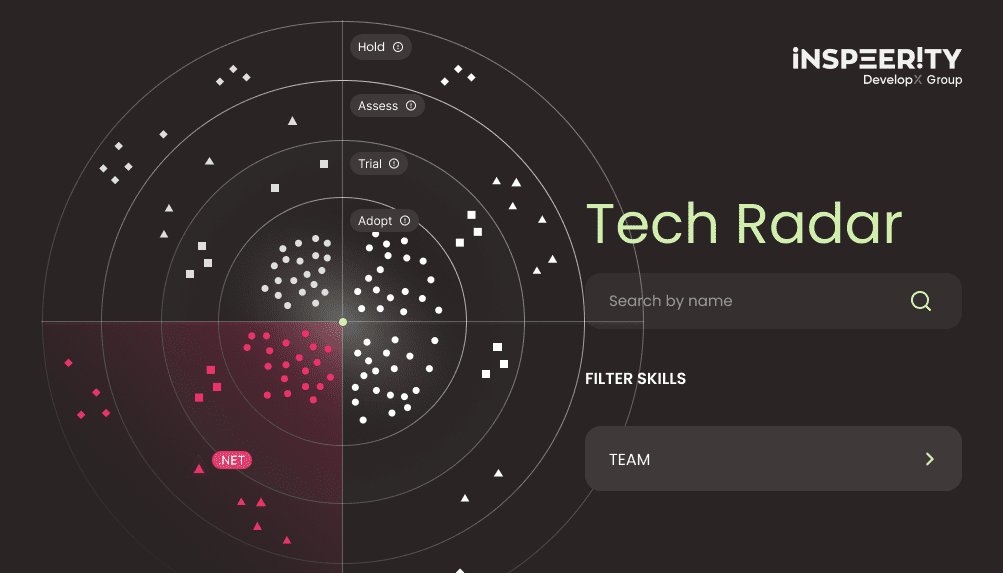Being a Business Development Manager (BDM) goes beyond just sales. It involves overseeing a partnership and ensuring the success of a project. At Inspeerity, we believe in this approach and once the contract is signed, the BDM takes on the role of Key Account Manager. The level of involvement may vary depending on the cooperation model chosen. In my previous article, I shared some more information about cooperation models we offer. For projects with team augmentation services, a Key Account Manager (KAM) may be necessary if there is no team leader in place. The main objective of the KAM is to ensure the satisfaction of both the development team and the client.
Today, I would like to discuss some of our leadership strategies that help us check the satisfaction of both the development team and the client. As well as ways to address any problems that may arise. Our Sales Team cooperates with Inspeerity’s C-Level Managers allowing us to learn on the fly.
3 Leadership Strategies To Improve Team Performance
1. Regular Status Meetings
In all our projects where Inspeerity delivers dedicated teams or team augmentation services, we hold weekly meetings. Such status meetings are organized once a week for 15-30 mins. Where the KAM and our COO Karol Wiszowaty, or one of ourTech Leaders such as Sebastian Dąbkowski and Piotr Filipowicz meet the Client. Such meetings are there to cover several important topics.
- Understanding the roadmap and the workload prediction.
- Having a bigger picture of client’s business and areas where Inspeerity could help.
- Identifying challenges from the client’s side and offering solutions.
- And of course – building relations between companies. And it’s for that reason, our cameras are always on during meetings.
2. Feedback Exchange Sessions
If there is no Team Leader in place from the Inspeerity side, we hold a feedback exchange session every first meeting of the month or quarter.
How Does it Work?
Before the call, both sides gather detailed feedback about the project itself. Inspeerity team members also discuss their input and thoughts about the project. During the exchange session we go through people, one by one, discussing their feedback. As a rule, team and tech leaders from the client’s side are invited in person, which allows for direct feedback. However, it’s important to say it’s not a one-way street, the KAM also shares the developer’s feedback with the client’s team.
Why do we do it?
These sessions are extremely productive as they allow us to keep track and record each team member’s performance and progress. It helps to identify weak points and prevent problems. Of course, from time to time some issues appear during such sessions and that’s the time we dig deeper to fix them.
What if the feedback isn’t only positive?
Words that are imprinted in my memory about negative feedback are: you cannot disagree about the feedback. The truth about opinions is, it’s not personal, it’s not judging, it’s not an attack. It’s how the other part sees your actions and behavior. So, the next step after receiving the feedback – evaluate it and set a road map for the future that both sides agree on.
3. Solving Problems
Even status meetings and regular feedback sessions cannot prevent burnouts. Or impact other factors that influence a developer’s performance. We must manage involvement that is not as promising as expected and is damaging for long-term cooperation. Let me tell you a story as an example.
Discovering the problem
A month after a new project started, we received warning signs from a client about the performance of one of the team members. Those warning signs were lateness in finalizing tasks, delayed responses and, a lack of communication from the dev’s side.
After receiving the feedback, I came to the developer for a transparent talk to discuss how he sees the situation.
It turned out that, as a senior dev, his intention was to deal with the framework and tasks by himself – not asking for help with things he didn’t know.
He shared his observations about task descriptions that might be improved. And as there was no acceptance criteria in place, he was struggling while delivering the task.
Moreover, tasks were time consuming and that impacted the delivery time. We discussed how he might split these tasks into smaller ones to be able to deliver.
Resolving the problem
After organizing a call with the client to discuss all the points, we discovered a solution. Splitting up the tasks and providing more detailed feedback would bring positive changes. I didn’t mention that this project was the first experience of cooperation with a software house for the customer. So, they also had lots of new things to learn about cooperating with a team. Once the issues were discussed and the actions points confirmed, we saw significant changes. In a couple of weeks, we saw improvements in communication. Progress with task delivery was faster and the developer had a deeper knowledge of the product. The most important change was the request from the developer for direct feedback. This shortened the time before issues appeared and led to resolving any issues faster.
Leadership Strategies in IT I’ve Learnt from C-Level Inspeerity Managers
Creating a positive work culture is essential to the success of any IT team. When employees feel empowered and supported, they are more likely to drive innovation and efficiency. In this regard, there are several key principles that can help IT managers create a positive and productive work environment.
- Empowerment: Encouraging employees to take initiative and ownership in their work. This can help drive innovation and efficiency within the IT team.
- Collaboration: Building a culture of teamwork and open communication. Where ideas and opinions are shared and valued. This helps to ensure that all team members are aligned and working towards a common goal.
- Flexibility: Adapting to change and encouraging employees to think outside the box. This is particularly important IT, where technology and processes are constantly evolving.
- Coaching and Mentorship: Providing support and guidance to team members. This helps them reach their full potential and develop their skills. This can help to build a strong and resilient team that is equipped to handle any challenges that may arise.
- Transparency: Building trust through open and honest communication. Keeping team members informed of decisions and developments that affect them. This helps to create a positive and supportive work environment, where everyone feels valued and included.
By implementing these principles, IT managers can ensure that their team is working towards a common goal and can adapt to the project’s needs.
My Final Thoughts
There are plenty of situations where KAM can apply leadership strategies. It’s crucial in helping companies improve their performance. Such strategies can also enhance culture, values and increase competitiveness. To improve team performance, Inspeerity uses regular status meetings. As well as feedback exchange sessions, and problem-solving techniques. Regular meetings help cover the workload, understand the client’s business, and identify challenges.
Feedback sessions help track each team member’s performance and progress. They help identify weak points and prevent problems. In case of issues, problem-solving techniques like transparent communication and detailed feedback help.
The leadership strategies mentioned above have enabled us to improve team performance and ensure the satisfaction of both the development team and the client. Once you are moving in the right direction there are more opportunities to grow the team with new coworkers. And that will be proof the KAM is doing his work well. That’s what I want to wish you.




